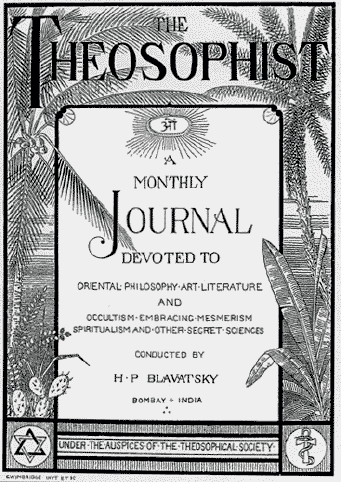When Blavatsky News started a year ago, there was no one source for finding current information about Helena Petrovna Blavatsky, though there were sites that dwelt with her past. After the publication last year of Michael Gomes’ abridging of The Secret Doctrine for Penguin (a book whose global accessibility was remarkable for any text by Blavatsky—one could see it at the Higginbotham’s bookshop at Chennai airport in India, or at London’s mega bookshop Foyles, or at the Borders book chain in America, usually paired with Gomes’s other abridgement, Isis Unveiled) and a rise of interest in Blavatsky, it led us some of us to believe that this elevation of Helena Petrovna Blavatsky in the public consciousness was worth documenting.
It was a timely move. The appearance of references to Blavatsky in so many wide and various places, as our coverage this year has shown, even surprised us. And we thank all those who have contributed to this project.
Although only one-tenth of all references to Blavatsky reported on this year came from theosophical sources—an indication of her pervasive influence—theosophists proved our loudest critics. And we soon learned, as G.R.S. Mead pointed out in the London Occult Review of May 1927, that “It is always easier for fanaticism in ‘Theosophical’ matters to regard an honest opponent as an unscrupulous ‘enemy’ than to give up long-cherished convictions—no matter how flimsily founded.”
There were posts on theosophical sites reprimanding us for pointing out what we thought were flaws in their portrayal of HPB, which we felt misrepresented her, and if implemented would have enhanced their position. Imagine, being condemned by theosophists for wanting to improve the image of Blavatsky! Truly we are in the Kali yuga. They forget, or perhaps never knew, that “The office of Teacher was always considered as a very solemn and responsible one among our Asiatic ancestors, and the pupil was always enjoined to obedience and loyalty. Saith the Scripture: ‘He who wipeth not away the filth with which the parent’s body may have been defiled by an enemy, neither loves the parent nor honors himself.’”
There were other theosophists who felt it their business to tell us not only what we should and shouldn’t be doing at this site, but how we should run our lives. We thought such attitudes went out of fashion with the 1960s, but see it has found a home among theosophists. This is a very telling position to adopt, especially in a movement that has always stressed its having no dogma or creed forced on its adherents, even going to the point where one organization passed a resolution urging its members to uphold “Freedom of Thought” for the beliefs of others. We suppose it is now freedom of thought as long as you keep it to yourself. Or freedom of thought without expression. HPB warned that “every such attempt at the Theosophical Society has hitherto ended in failure, because, sooner or later, it has degenerated in to sect, [and] set up hard and fast dogmas of its own.” Once you start condemning people for how they choose to live their lives you are betraying your own ideals and those that Blavatsky worked for. It also shows a lack of awareness of how other parts of the theosophical movement work, and even how esoteric groups function.
But, as we are happy to learn from any source, these attitudes have revealed to us why, when Blavatsky’s name recognition has reached such a level on the social indicator, it has not translated to adherents for the organized parts of the movement. If anything, membership is declining precipitously. And in America where these critics are, “membership in the American Section [of the Theosophical Society] has fallen by approximately two hundred and fifty members” in the past year, according to the latest information supplied by the international President at the Society’s recent convention in Adyar. Perhaps these critics should learn from Annie Besant’s words, when she was editor of Lucifer with HPB, “Where members have shrunk from their defence of their Teacher, the Society has languished; where they have loyally supported her, the Society has flourished.”—“The Theosophical Society and H.P.B.,” Lucifer, March 1891, p. 61.
These people put us in the unenviable position, as one reader wrote in, of “having to choose between letting prominent charlatans mislead their audiences unchallenged, or else elevating them by engaging their blather and forgoing better conversations.” And all because of our holding up the mirror of truth and showing the ugly distortion it reflected.
We would remind such critics, who consider themselves theosophists, of Blavatsky’s words:
The efforts of those members who benefit the Cause should never be impeded by criticism on the part of others who do nothing, but all should be encouraged and as much help given as is possible, even if that assistance be limited through circumstances to mere encouragement. Every sincerely based work for theosophy will bear good fruit, no matter how inappropriate it may appear in the eyes of those members who have set to themselves and everybody else only one definite plan of action.
And you want to be an occultist?









